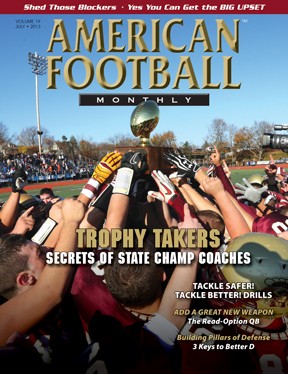Article CategoriesAFM Magazine
|
Developmental Tackling, Part I – Effectively using the shimmy technique can help ensure the safety of all defensive players.by: Brent SteuerwaldRetired Head Coach Shenendehowa High School (NY) © More from this issue Without question, teaching safe tackling skills and drills is one of the most demanding tasks every coach in the country must master. In my 54 years of coaching varsity football, nothing gave me more concern than the idea of a collision with a player’s head down, chin on chest, and the resulting straight line spinal column hit with the top of the helmet. That is almost always the primary cause of paraplegic injury. That is why so much emphasis is placed on converting the speed run of pursuit to the power run in preparation of safe but effective hitting. Players can learn to control approach by lowering weight, shortening the steps, turtling the neck and hitting on the rise with eyes high. Collisions can be violent and still safe. Remember the objective of tackling is to be safe and consistent and get the ball carrier on the ....The full article can only be seen by subscribers.
|
|
|||||||
| HOME |
MAGAZINE |
SUBSCRIBE | ONLINE COLUMNISTS | COACHING VIDEOS |
Copyright 2025, AmericanFootballMonthly.com
All Rights Reserved





